Python GUI佈局工具Tkinter使用方法是什麼
圖形使用者介面(GUI)
圖形使用者介面(GUI) 只不過是一個桌面應用程序,可幫助我們與電腦進行互動
像文字編輯器這樣的GUI 應用程式可以建立、讀取、更新和刪除不同類型的檔案
數獨、國際象棋和紙牌等應用程式則是遊戲版的GUI程式
還有Google Chrome、Firefox 和Microsoft Edge 之類的GUI 應用程式是用來瀏覽Internet 的
#這些都是我們日常在電腦上使用的一些不同類型的GUI 應用程序,其實我們透過Tkinter 也是可以建立簡單的類似應用程式的
今天我們作為GUI 的入門,將創建一個非常簡單且漂亮的GUI 應用程式
用於創建GUI的Python 庫
Python 有大量的第三方類別庫,對於GUI 庫,主要有以下幾種:
Kivy
Python QT
wxPython
Tkinter
其中,Tkinter 是許多學習者和開發者的首選,因為它簡單易用而且隨Python 安裝自帶
Tkinter 基礎
下面的圖片顯示了應用程式是如何在Tkinter 中實際執行

#我們首先導入Tkinter 模型,接著,我們創建主窗口,在這個窗口中,我們將要執行操作並顯示一切視覺效果,接下來我們加入Widgets,最後我們進入Main Event Loop
這裡有2 個重要的關鍵字
Widgets
Main Event Loop
事件循環基本上是告訴程式碼繼續顯示窗口,直到我們手動關閉它,是在後台無限循環運行的
對於Widgets 我們後面單獨學習
下面一個程式碼例子,來深入理解下
import tkinter
window = tkinter.Tk()
# to rename the title of the window window.title("GUI")
# pack is used to show the object in the window
label = tkinter.Label(window, text = "Hello World!").pack()
window.mainloop()我們匯入Tkinter 套件並定義一個窗口,接著我們可以修改一個視窗標題,每當打開應用程式時,該標題都會顯示在標題選項卡上
最後,我們還定義了一個標籤,標籤只不過是需要在視窗上顯示的輸出,在例子中是hello world

Tkinter Widgets
那麼到底什麼是Widgets 呢
Widgets 類似HTML 中的元素,我們可以在Tkinter 中找到針對不同類型元素的不同類型的Widgets
讓我們看看Tkinter 中所有這些Widgets 的簡要介紹

Canvas - Canvas 使用於在GUI 中繪製形狀
Button – Button 用於在Tkinter 中放置按鈕
- ##Checkbutton – Checkbutton 用於在應用程式中建立複選按鈕
- Entry - Entry 用於在GUI 中建立輸入欄位
- Frame – Frame 在Tkinter 中用作容器
- Label - Label 用於建立單行Widgets,如文字、圖片等
- Menu - Menu 用於在GUI 中建立選單
l1 = Label(window, text="萝卜大杂烩!", font=("ArialBold", 50))
l1.grid(column=0, row=0)
l1 = Label(window, text="萝卜大杂烩!", font=("ArialBold", 50))
window.geometry('350x200')在這種情況下,我們將其設置為寬350 像素和高200 像素接下來是button#Button按鈕與標籤非常相似,我們建立一個變數並使用Widgets 語法來定義按鈕要表達的內容window.geometry('350x200') bt = Button(window, text="Enter")

bt = Button(window, text="Enter", bg="orange", fg="red") bt.grid(column=1, row=0)

def clicked():
l1.configure(text="按钮被点击了!!")
bt = Button(window, text="Enter", bg="orange", fg="red", command=clicked)這個我們稱之為點擊事件,我們需要編寫有關單擊按鈕或觸發單擊事件時應該發生什麼的功能#我們定義了一個名為clicked 的函數,可以顯示一則文字訊息,我們在按鈕定義中新增一個名為command 的參數,來呼叫點擊事件
Entry
它用于在 GUI 中创建输入字段以接收文本输入
txt = Entry(window, width=10)
txt.grid(column=1, row=0)
def clicked():
res = "Welcome to " + txt.get()
l1.configure(text=res)
bt = Button(window, text="Enter", bg="orange", fg="red", command=clicked)在这里,我们使用 Tkinter Entry 类创建一个文本框,grid 定义我们希望窗口小部件位于何处
同时 clicked 函数接收 Entry 的文本信息

Combobox
这是一个带有某些选项的下拉菜单
from tkinter.ttk import * combo = Combobox(window) combo['values']= (1, 2, 3, 4, 5, "Text") combo.current(3) combo.grid(column=0, row=0)

这样一个下拉菜单就完成了
Checkbutton
复选按钮是非常常用的组件
chk_state = BooleanVar() chk_state.set (True) chk = Checkbutton(window, text="Select", var=chk_state) chk.grid(column=4, row=0)
我们首先创建一个 booleanvar 类型的变量,这是一个 Tkinter 变量
默认情况下,我们将设置状态保持为 true,这代表按钮已经被选中 接下来,我们将 chk_state 传递给 checkbutton 类来为我们设置检查状态

Radio Button
单选按钮也是非常常用的
rad1 = Radiobutton(window, text=Python', value=1) rad2 = Radiobutton(window, text=Java', value=2) rad3 = Radiobutton(window, text=Scala', value=3) rad1.grid(column=0, row=0) rad2.grid(column=1, row=0) rad3.grid(column=2, row=0)
在这里,我们使用了不同的参数值,1,2和3,如果它们相同,则会导致冲突并出现错误
它们的文本数据是可以相同,在这里,我们使用了 Python、Java 和 Scala
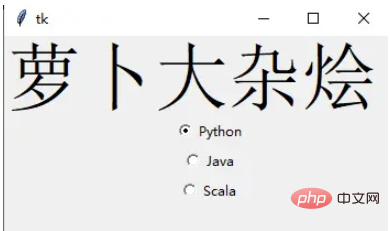
Scrolled Text
滚动文本组件
scro_txt = scrolledtext.ScrolledText(window, width=40,height=10) scro_txt.grid(column=0, row=4)
我们指定了窗口的高和宽,否则默认会填充整个 Windiws 窗口
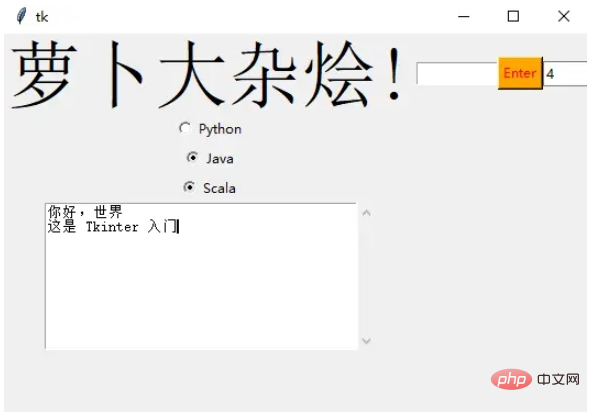
Message Box
消息组件可以方便的弹出提醒消息
def clicked():
messagebox.showinfo('Message title', 'Message content')
btn = Button(window,text=‘ENTER', command=clicked)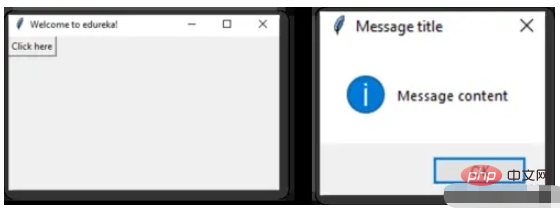
SpinBox
Spinbox 也是一个常见的组件,有两个选项卡,存在向上和向下滚动选项卡
pin = Spinbox(window, from_=0, to=100, width=5)
有 3 个参数——from、to 和 width
From – 告诉我们范围的开始和默认值
to – 给我们范围的上限阈值
width 基本上是将 widget 的大小设置为5个字符的空格
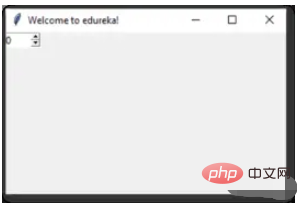
Geometry
Tkinter 中的所有 Widgets 都会有一些位置信息,这些度量使得我们可以组织 Widgets 及其父框架、窗口等
Tkinter 具有以下三个布局方式
pack():- 它在块中组织 Widgets,这意味着它占据了整个可用宽度,这是在窗口中显示 Widgets 的标准方法
grid():- 它以类似表格的结构组织 Widgets
place():- 它将 Widgets 放置在我们想要的特定位置
组织布局
为了在窗口中安排布局,我们将使用 Frame 类
Frame -- 在窗口中创建分区,我们可以根据需要使用 pack() 方法的侧面参数对齐框架
Button -- 在窗口中创建一个按钮,需要传递几个参数,如文本(按钮的值)、fg(文本的颜色)、bg(背景颜色)
在下面的代码中,我们使用 window、top_frame、bottom_frame 来布局
import tkinter
window = tkinter.Tk()
window.title("GUI")
# creating 2 frames TOP and BOTTOM
top_frame = tkinter.Frame(window).pack()
bottom_frame = tkinter.Frame(window).pack(side = "bottom")
# now, create some widgets in the top_frame and bottom_frame
btn1 = tkinter.Button(top_frame, text = "Button1", fg = "red").pack()# 'fg - foreground' is used to color the contents
btn2 = tkinter.Button(top_frame, text = "Button2", fg = "green").pack()# 'text' is used to write the text on the Button
btn3 = tkinter.Button(bottom_frame, text = "Button2", fg = "purple").pack(side = "left")# 'side' is used to align the widgets
btn4 = tkinter.Button(bottom_frame, text = "Button2", fg = "orange").pack(side = "left")
window.mainloop()
再来看一个登录的小栗子
import tkinter
window = tkinter.Tk()
window.title("GUI")
# creating 2 text labels and input labels
tkinter.Label(window, text = "Username").grid(row = 0) # this is placed in 0 0
# 'Entry' is used to display the input-field
tkinter.Entry(window).grid(row = 0, column = 1) # this is placed in 0 1
tkinter.Label(window, text = "Password").grid(row = 1) # this is placed in 1 0
tkinter.Entry(window).grid(row = 1, column = 1) # this is placed in 1 1
# 'Checkbutton' is used to create the check buttons
tkinter.Checkbutton(window, text = "Keep Me Logged In").grid(columnspan = 2) # 'columnspan' tells to take the width of 2 columns
# you can also use 'rowspan' in the similar manner
window.mainloop()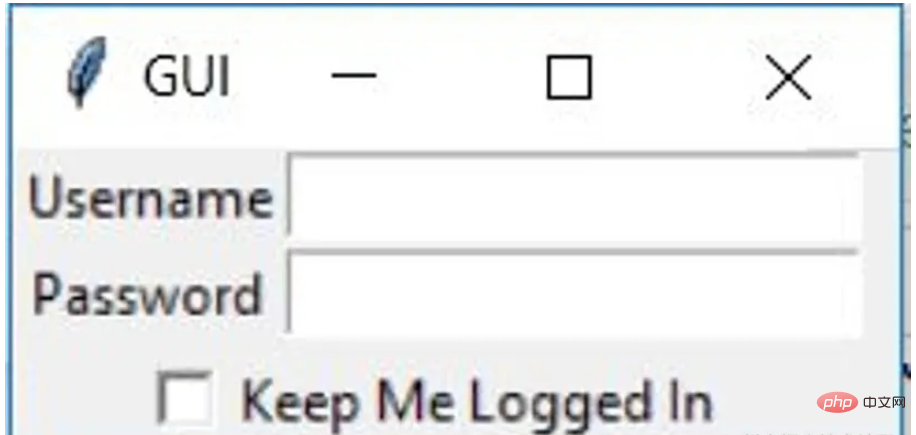
下面我们来了解 binding 函数
binding 函数
每当事件发生时调用函数就是绑定函数
在下面的示例中,当单击按钮时,它会调用一个名为 say_hi 的函数。 函数 say_hi 会创建一个带有文本 Hi 的新标签
import tkinter
window = tkinter.Tk()
window.title("GUI")
# creating a function called say_hi()
def say_hi():
tkinter.Label(window, text = "Hi").pack()
tkinter.Button(window, text = "Click Me!", command = say_hi).pack() # 'command' is executed when you click the button
# in this above case we're calling the function 'say_hi'.
window.mainloop()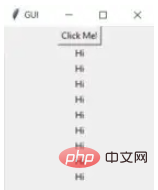
另一种绑定函数的方法是使用事件,事件类似于鼠标移动、鼠标悬停、单击和滚动等等
import tkinter
window = tkinter.Tk()
window.title("GUI")
# creating a function with an arguments 'event'
def say_hi(event): # you can rename 'event' to anything you want
tkinter.Label(window, text = "Hi").pack()
btn = tkinter.Button(window, text = "Click Me!")
btn.bind("Button-1", say_hi) # 'bind' takes 2 parameters 1st is 'event' 2nd is 'function'
btn.pack()
window.mainloop()单击事件有 3 种不同的类型,分别是 leftClick、middleClick 和 rightClick
下面的代码将使用对于的文本创建一个新标签
import tkinter
window = tkinter.Tk()
window.title("GUI")
#creating 3 different functions for 3 events
def left_click(event):
tkinter.Label(window, text = "Left Click!").pack()
def middle_click(event):
tkinter.Label(window, text = "Middle Click!").pack()
def right_click(event):
tkinter.Label(window, text = "Right Click!").pack()
window.bind("Button-1", left_click)
window.bind("Button-2", middle_click)
window.bind("Button-3", right_click)
window.mainloop()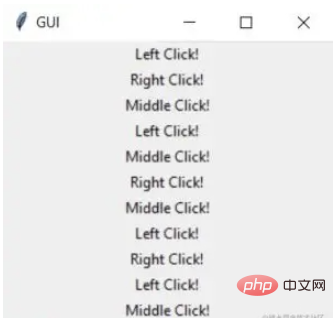
Images 和 Icons
我们可以使用 PhotoImage 方法添加图像和图标
import tkinter
window = tkinter.Tk()
window.title("GUI")
# taking image from the directory and storing the source in a variable
icon = tkinter.PhotoImage(file = "4.PNG")
# displaying the picture using a 'Label' by passing the 'picture' variriable to 'image' parameter
label = tkinter.Label(window, image = icon)
label.pack()
window.mainloop()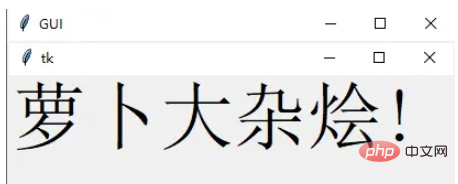
好了,进步的 Tkinter 知识我们都梳理完毕了,下面就完成一个简单的实战项目吧
计算器 APP
首先初始化页面
window = Tk()
window.geometry("350x380")
window.resizable(0, 0) # this prevents from resizing the window
window.title("小小计算器")接下来定义输入数字框
input_text = StringVar()
input_frame = Frame(window, width=312, height=50, bd=0, highlightbackground="black", highlightcolor="black",
highlightthickness=1)
input_frame.pack(side=TOP)
input_field = Entry(input_frame, font=('arial', 18, 'bold'), textvariable=input_text, width=50, bg="#eee", bd=0,
justify=RIGHT)
input_field.grid(row=0, column=0)
input_field.pack(ipady=10)然后定义按钮方法,我们以清除按钮和除法按钮为例
clear = Button(btns_frame, text="C", fg="black", width=32, height=3, bd=0, bg="#eee", cursor="hand2",
command=lambda: btn_clear()).grid(row=0, column=0, columnspan=3, padx=1, pady=1)
divide = Button(btns_frame, text="/", fg="black", width=10, height=3, bd=0, bg="#eee", cursor="hand2",
command=lambda: btn_click("/")).grid(row=0, column=3, padx=1, pady=1)最后就是计算equal逻辑
equals = Button(btns_frame, text="=", fg="black", width=10, height=3, bd=0, bg="#eee", cursor="hand2",
command=lambda: btn_equal()).grid(row=4, column=3, padx=1, pady=1)
def btn_equal():
global expression
result = str(eval(expression))
input_text.set(result)
expression = ""以上是Python GUI佈局工具Tkinter使用方法是什麼的詳細內容。更多資訊請關注PHP中文網其他相關文章!

熱AI工具

Undress AI Tool
免費脫衣圖片

Undresser.AI Undress
人工智慧驅動的應用程序,用於創建逼真的裸體照片

AI Clothes Remover
用於從照片中去除衣服的線上人工智慧工具。

Clothoff.io
AI脫衣器

Video Face Swap
使用我們完全免費的人工智慧換臉工具,輕鬆在任何影片中換臉!

熱門文章

熱工具

記事本++7.3.1
好用且免費的程式碼編輯器

SublimeText3漢化版
中文版,非常好用

禪工作室 13.0.1
強大的PHP整合開發環境

Dreamweaver CS6
視覺化網頁開發工具

SublimeText3 Mac版
神級程式碼編輯軟體(SublimeText3)
 如何在Python中創建虛擬環境
Aug 05, 2025 pm 01:05 PM
如何在Python中創建虛擬環境
Aug 05, 2025 pm 01:05 PM
創建Python虛擬環境可使用venv模塊,步驟為:1.進入項目目錄執行python-mvenvenv創建環境;2.Mac/Linux用sourceenv/bin/activate、Windows用env\Scripts\activate激活;3.使用pipinstall安裝包、pipfreeze>requirements.txt導出依賴;4.注意避免將虛擬環境提交到Git,並確認安裝時處於正確環境。虛擬環境能隔離項目依賴防止衝突,尤其適合多項目開發,編輯器如PyCharm或VSCode也
 在Python中調試內存洩漏的常見策略是什麼?
Aug 06, 2025 pm 01:43 PM
在Python中調試內存洩漏的常見策略是什麼?
Aug 06, 2025 pm 01:43 PM
Usetracemalloctotrackmemoryallocationsandidentifyhigh-memorylines;2.Monitorobjectcountswithgcandobjgraphtodetectgrowingobjecttypes;3.Inspectreferencecyclesandlong-livedreferencesusingobjgraph.show_backrefsandcheckforuncollectedcycles;4.Usememory_prof
 如何與Python的時區合作?
Aug 05, 2025 pm 04:53 PM
如何與Python的時區合作?
Aug 05, 2025 pm 04:53 PM
use usezoneInInfoforpython3.9 toCreateTimeZone-wardEteTimesandConvertBetBetWeenTimeZonesWithAstimeZone(); 2.Forpython3.6–3.6-3.6-3.6,useppypytzwithlocalize()
 如何使用Python自動化從Excel到Web表單的數據輸入?
Aug 12, 2025 am 02:39 AM
如何使用Python自動化從Excel到Web表單的數據輸入?
Aug 12, 2025 am 02:39 AM
使用Python自動化將Excel數據填入網頁表單的方法是:先用pandas讀取Excel數據,再用Selenium控制瀏覽器自動填寫並提交表單;具體步驟包括安裝pandas、openpyxl和Selenium庫,下載對應瀏覽器驅動,用pandas讀取data.xlsx文件中的Name、Email、Phone等字段,通過Selenium啟動瀏覽器打開目標網頁,定位表單元素並逐行填入數據,使用WebDriverWait處理動態加載內容,添加異常處理和延遲確保穩定性,最後提交表單並循環處理所有數據行
 如何根據其值對Python字典進行分類?
Aug 05, 2025 am 03:32 AM
如何根據其值對Python字典進行分類?
Aug 05, 2025 am 03:32 AM
要排序字典的值,使用sorted()函數配合dict.items()和key參數;1.使用lambdaitem:item[1]按值升序排序;2.添加reverse=True實現降序排序;3.可用operator.itemgetter(1)替代lambda以提升可讀性和性能;字典在Python3.7 中保持插入順序,原字典不變,返回新字典,若值類型混雜需額外處理,最終模式為dict(sorted(d.items(),key=lambdax:x[1]))。
 如何在Python類中實現自定義迭代器?
Aug 06, 2025 pm 01:17 PM
如何在Python類中實現自定義迭代器?
Aug 06, 2025 pm 01:17 PM
Define__iter__()toreturntheiteratorobject,typicallyselforaseparateiteratorinstance.2.Define__next__()toreturnthenextvalueandraiseStopIterationwhenexhausted.Tocreateareusablecustomiterator,managestatewithin__iter__()oruseaseparateiteratorclass,ensurin
 如何在Python中打印出JSON文件?
Aug 07, 2025 pm 12:10 PM
如何在Python中打印出JSON文件?
Aug 07, 2025 pm 12:10 PM
要美化打印JSON文件,需使用json模塊的indent參數,具體步驟為:1.使用json.load()讀取JSON文件數據;2.使用json.dump()並將indent設為4或2寫入新文件,即可生成格式化後的JSON文件,完成美化打印。
 如何在VSCODE中設置Python虛擬環境
Aug 06, 2025 am 02:30 AM
如何在VSCODE中設置Python虛擬環境
Aug 06, 2025 am 02:30 AM
創建虛擬環境:在項目文件夾中運行python-mvenvvenv。 2.激活虛擬環境:Windows使用venv\Scripts\activate,macOS/Linux使用sourcevenv/bin/activate。 3.在VSCode中打開項目並按Ctrl Shift P選擇Python解釋器,指定虛擬環境中的解釋器。 4.驗證是否生效:運行importsys;print(sys.executable),輸出路徑應指向venv文件夾。 5.可選配置:在設置中啟用python.terminal.a







